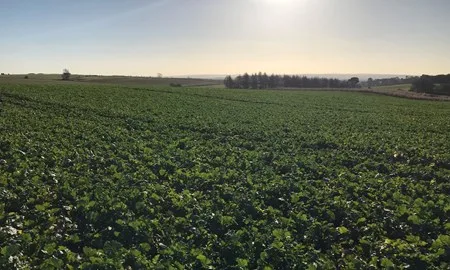
Get the latest insight and expert advice for your farm. Tom Astill assesses what agronomy tasks might need doing on farms in the west in February.
Author
Tom Astill | 24th January 2022Four insights into improving crop agronomy this February in the west
Crop Progress
After a good autumn, there’s more winter cereals in the ground. Depending on drilling date, growth stages in mid-January varied from GS12 through to well-tillered.
Oilseed rape is fairly forward depending on site. There are some cabbage stem flea beetle larvae in some crops, while pigeons are appearing, which will need managing particularly with high oilseed rape prices.
Tom’s agronomy tips for February
1. Assess winter wheat crops for spring weed control
Efficacy of pre-emergence autumn residual herbicides has generally been good, helped by seedbeds of better quality than those of the past two autumns. In earlier-sown crops the pre-emergence residual herbicide half-life has reduced by warmer early autumn temperatures. In such fields weeds are starting to pop through, especially where no follow up residual was used. Later October-sown crops are looking reasonably clean.
Prioritise walking fields where weeds might be starting to emerge, especially if autumn residuals were not applied for any reason. Assessing both weed spectrum and weed size will help focus sprays to the fields which most need challenging weeds to be dealt with earlier rather than later.
If black-grass or rye-grass is at the 2-3 leaf stage, is actively growing, has a dry or drying leaf and you’re able to travel, try to hit those challenging grass weeds while they are still small with Atlantis OD (mesosulfuron + iodosulfuron). Pacifica Plus (mesosulfuron + iodosulfuron + amidosulfuron) can be used at 0.4 kg/ha from 1 February or 0.5 kg/ha from 1 March – the higher rate should only be applied if bromes are the predominant grass weed. The amidosulfuron component will widen the spectrum of broad leaf weed control.
Where the more difficult to control grass weeds are not an issue, Othello (mesosulfuron + iodosulfuron + diflufenican) is a good alternative for annual meadow grass and broadleaf weeds.
2. Monitor for light leaf spot in oilseed rape
A lot of growers will have sprayed a single autumn fungicide in oilseed rape. There are some big canopies currently and they are visually fairly clean from disease. That doesn’t always mean there isn’t disease, especially light leaf spot because of its long latent period.
That’s where our SpotCheck service is useful for checking whether crops are infected. Leaf samples are sent to ADAS for incubation and identification of all oilseed rape diseases. You can register for a sample kit here.
The SpotCheck results should be used alongside knowledge of variety disease resistance ratings, drilling date and weather to decide whether a fungicide application is required. If you do need to treat, Proline 275 (prothioconazole) is a good option for light leaf spot control.
It will also be worth assessing green area index in oilseed rape this year – these bigger canopies can contain quite a lot of nitrogen so it will be cost effective to do those calculations for the nitrogen cost savings.
3. Tailor glyphosate rates to the most difficult species
Glyphosate application is a tried and tested way to terminate cover crops and manage overwintered stubbles for the cleanest start in the next crop.
Many cover crops have been terminated already ahead of spring cereals but the timing of application depends on your cultivation/drilling system, cover crop species and the following cash crop. For situations ahead of spring cereals to be drilled with a non-direct drill, I would advise terminating the cover 4-6 weeks ahead of drilling so that biomass is sufficiently broken down. If you still have covers growing, and are planning to use glyphosate, match the rate to the most challenging target species.
Much of the required dose information for weeds species is on the label and we have conducted trials to determine the optimum glyphosate dose range for various cover crop species.
Lower doses are required for cereals and phacelia, with higher rates for brassicas and especially legumes, like vetches. Consider increasing water volumes for large canopies to improve coverage.
For resistance management it is better to avoid needing multiple applications, although follow up applications may be required if the cover crop had a large canopy which shielded weeds. For more information on minimising the risk of glyphosate resistance, please look at the latest WRAG guidelines.
The surfactants in Roundup products improve the spreading of the product on the leaf and they enhance penetration through the leaf cuticle. Roundup products do work in cool conditions, albeit more slowly than in warmer growing conditions, but if there is a period of frost, plant metabolism will shut down and translocation of glyphosate the roots and shoot will be limited, so just be aware of that when timing applications.
4. Consider signing up for a FieldView trial
Ahead of spring drilling it is still possible to sign up for a year’s trial of our digital farming platform, Climate FieldView. FieldView can be used to collect and exchange data direct from machinery or from systems such as Gatekeeper, Omnia and JD Link, into one platform where it can be analysed. You can use this data to help inform or create maps for variable rate applications of seed and fertiliser, which this spring might be very useful to increase input use efficiency.